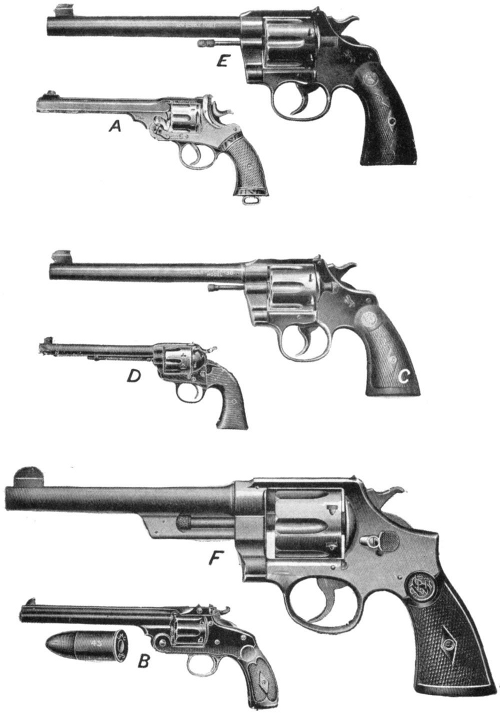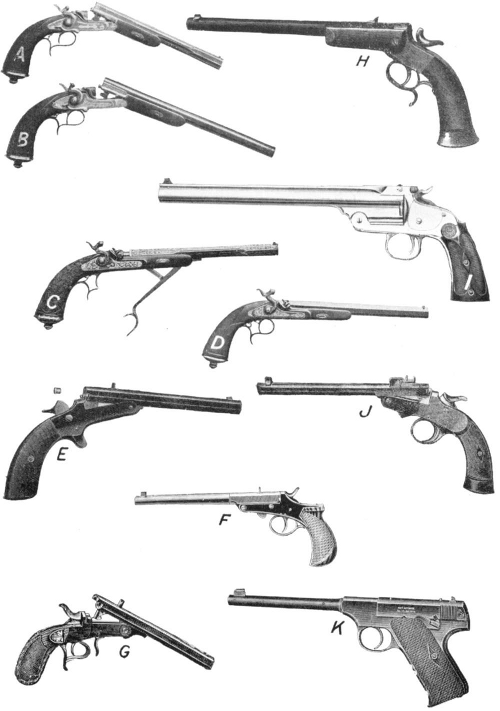The following information on target pistols and revolvers comes from The Book of the Pistol and Revolver by Hugh B. C. Pollard. The Book of the Pistol and Revolver is also available to purchase in print.
The target revolver, as used in competitions at Bisley under the rules of the National Rifle Association, in the U.S.A. under the United States Revolver Association, and in other countries under similar national bodies, is usually of the standard military calibre of the country in question, and subject to definite rules as regards length of barrel, trigger-pull, adjustable sights, etc., unless where otherwise specified in the rules of the competitions.
The length of barrel for a target revolver for use at Bisley must not exceed 7 1/2 inches, and the most popular models are the Colt “New Service” .455 British 7 1/2-inch barrel, the Smith and Wesson of similar type and calibre, and the Webley W.G. Target model, or the Webley-Scott with target sights and long barrel. The single-action S.W. Russian model and the Frontier and Bisley model Colts were for a long time favourites, but now all single-action revolvers are practically obsolete, the S.W. tip-up action of old pattern having been barred at Bisley as liable to blow open at the breech, under the strain of smokeless powder.

Modern conditions demand that the fore-sight of a revolver shall be fixed and incapable of adjustment, but the back-sight may be capable of lateral movement. On military models neither sight may be movable, and the rear-sight usually consists of a plain slot or notch in the top strap of the frame, while the fore-sight is a plain section of metal, either milled integrally with, or set immovably into, the end of the barrel. Military fore-sights should be rounded, in order to insure freedom in drawing the weapon from a holster.
On Target models a bead or “Ira-Paine” foresight is popular, and such sights, when sent out from the makers, are cut with a tapering bead, so that any size of bead to suit the user can be made by filing the length of the sight to the requisite size. Many experts prefer a plain square fore-sight with a square notch in the back-sight in place of the bead and V-shaped rear notch, and back-sights of varying heights for different ranges are issued by the makers of target revolvers.

In general, it is best to select the sight that suits your own personal individuality, rather than to be persuaded that So-and-so’s speciality is bound to suit you; as a hard-and-fast rule, the plainest sight that you can use is the best to adopt.
A great deal of refinement can be expended upon the adjustment of trigger-pull of target weapons. The official pull is a minimum of 4 lbs. for revolvers, but many private shots have weapons (unusable in competitions) with a 2 lb. trigger-pull. It is essential that there should be no “creep” or “drag” to the pull, and adjustments must be made by a skilled gunsmith, and should not be attempted by amateurs. If, however, this is done, it should be remembered that after the scear and hammer notch have been gently filed to nearly the suitable adjustment, finishing off is done by means of small triangular slips of stones of varying degrees of cutting surface; these leave the metal in a polished or burnished condition, and it is only by their use that variations of an ounce or so can be effected.
Outside the limits set by international competition usage come a wide variety of target models of various calibres, both pistols and revolvers, suitable for private use or “open events.”
Among the revolvers suitable for this are the .38 Officers’ Model Target Colt, which is a replica of the larger New Service Target, and a splendidly accurate weapon. The .32 Police Positive, with target length barrels 7-1/2 inches or 6 inches, and target sights, make excellent weapons for the use of ladies, the light charge and low recoil rendering the weapon pleasant and comfortable to use. The .22 Target Colt is chambered for the .22 long rifle cartridge, and is the only first-class .22 revolver of any use for target work at present on the market.
The Smith and Wesson models are also marketed in similar calibres and types, and a variety of cheap American pistols, fitted with speciously named “Wild and Woolly West Target Stocks,” etc., are also to be bought. These weapons, while quite excellent for house defence and similar onerous duty, do not standup to prolonged use, and are useless as target revolvers or for any duty where much shooting is expected of them. The cheap .22 weapons are usually unsatisfactory and “keyhole” badly. To buy cheap revolvers is waste of money, as in order to get good results the best materials and workmanship are necessary; also, if you ever want a revolver you will want a reliable one. The thirty-shilling specimen is worthless as a competitor against the three-pound weapon of reputable make, and to buy the best is the only real economy. Cheap foreign pistols of the twelve and sixpenny variety are more dangerous to their users than to anybody else, and should be avoided at all costs.
Turning from the target revolver to the target pistol we find a range of .22 calibre weapons by good makers, inexpensive to purchase and capable of the highest accuracy.
The Webley .22 Target Pistol has a pleasant grip and balance, while the .22 semi-automatic manufactured by the same firm is an ideal pistol for accustoming one’s self to the grip of an automatic, and for general target or sporting use. The new Colt .22 Target Automatic is also excellent.
The Smith and Wesson single shot pistol is made in a range of calibres from .22 to .38 rimfire, as are many other American pistols; but as all cartridges, with the exception of the .22 in variations up to the “long rifle” size, are hard to get in England from the average gunsmith, unless specially ordered, and quite unobtainable in most parts of the globe, the .22 calibres are the only ones worth considering for the average user. The latest model .22 S. and W. has a double action, the only target pistol so equipped.
The Stevens pistols of .22 calibre are made in varying weights and several models, called “Diamond,” “Gould,” and “Conlin,” of which the “Gould” is the most popular with target shooters. The action is simple, and on the tip-up system, with an automatic extractor to push out the cartridge when the barrel is depressed. The only difference between the models is the weight and shape of the grip. The Smith and Wesson pistols, like their revolvers, have the same hinge tip-up action extractor and top fastening, while the Webley target pistol and most Continental weapons have a kick ejector of the hinge type. The Webley semi-automatic is unusual in design. Built on very similar lines to the Webley .32 pocket automatic, but without the magazine and recoil springs to close the action, the weapon, when fired, blows open, ejecting the empty shell and cocking the hammer for the next shot. The breech is left open for reloading, and the user has only to put in another cartridge and close the sliding breech to be ready for the next shot. An additional extractor on the barrel is provided for use in case of a broken-rimmed cartridge, or the mechanism not functioning properly.
This pistol can also be fitted with a detachable shoulder stock, and forms, when so fitted, an exceedingly convenient portable rifle.
The German, Belgian, and French makers turn out some wonderfully complicated .22 target pistols with adjustable sights and curiously-shaped crutch handles. These weapons are often fitted with hair triggers and a variety of automatic ejectors and other fitments; unfortunately, the soft materials of which they are made, and the typically bad workmanship of the Continental gunsmith, make them so delicate and unreliable as to render them practically worthless for ordinary use. When in going order extraordinarily accurate shooting can be made with them, and for trick work, like picking off the pips of the ace of clubs, they are invaluable.
The .22 cartridge is exceedingly accurate, and is the only size that it is safe to use in such a thickly populated country as England, unless shooting is done upon a properly constructed range. Up to 50 yards the .22 short gives excellent results, but for longer distances, either the .22 long or .22 “long rifle” should be used. These give accurate results at 100 yards and over. In target revolvers of this calibre the .22 Long Rifle “Armory” model should be used, as the bullet is in this type crimped into the shell. If the uncrimped varieties are used in a revolver, there is a tendency for the recoil to loosen the bullets in the adjoining chambers, with the result that their noses project and prevent the cylinder from revolving for the next shot. In all .22 weapons smokeless powder should be used, and it should also be remembered that the corrosive effects of the gases of heavy fulminate of mercury charge in the rim are greater than is usual with centre-fire cartridges, so the weapons should be cleaned with cordite cleanser, as well as ordinary oil.
For the shot who wishes to compete at Bisley a .455 calibre revolver of approved pattern is essential, but the man who wants a target pistol for use in his own grounds and for his own amusement rather than for serious competition work can be confidently advised to invest in a good .22 revolver or pistol with its cheap ammunition, exceptional accuracy, and greater margin of safety for the neighbourhood. Above all things, avoid the “special revolvers,” chambered for odd gallery-sized cartridges, such as the .38-44 Smith and Wesson that have been so much praised in various works. The reason is simple—though the pistol may be excellent, the cartridges are practically unobtainable, unless specially loaded in lots of 1,000 or more, expensive, and no better than the standard models.
For folk who prefer a heavier charge than the .22 and like a revolver that can be used as a serviceable weapon for self-defence or travelling abroad, but who dislike the heavy military models, or for ladies who dislike the heavy recoil of the .455, the range of target revolvers of .38 and .32 with 6-inch barrels should easily provide an ideal all-round weapon.
